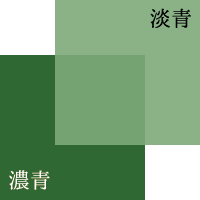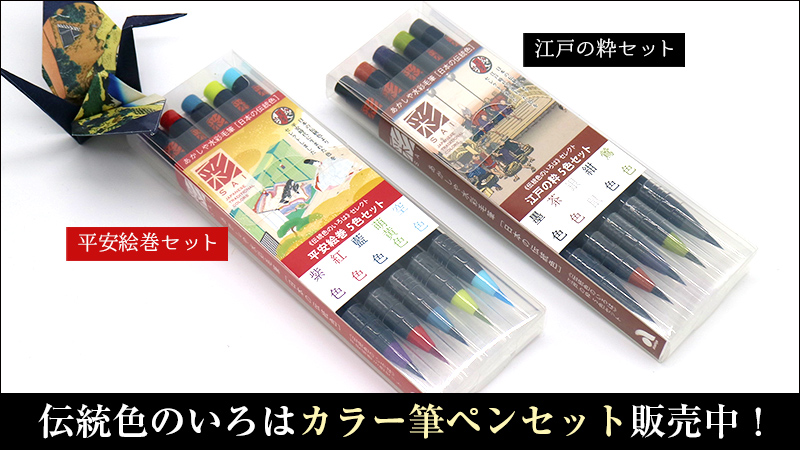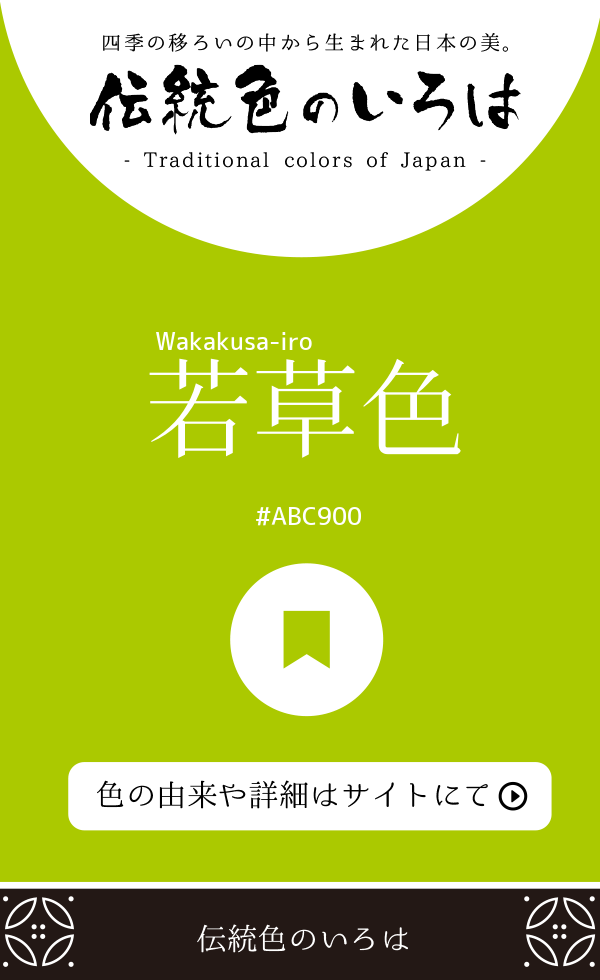| 色の名前Japan Color Name | 若草色(わかくさいろ) |
|---|---|
| ローマ字Romanized | Wakakusa-iro |
| RGB | R:171 G:201 B:0 |
| CMYK | C:38 M:00 Y:100 K:05 |
| Web カラーHex triplet | |
| 誕辰色 | 2月5日 |
色の説明
若草色(わかくさいろ)とは、早春に芽吹いた若草のようなあざやかな黄緑のことです。古くから見られる伝統的な色で、もとは平安装束の重 ねの色目『若草』に由来します。
「若」には新鮮な、未熟な、新しいなどの意味があり、俳句では「若草」は春の季語です。また、平安前期の歌物語「伊勢物語 」では、みずみずしさを感じさせる「若草」は若い女性に例えられました。
 由来となった『若草』の重 ねの色ですが、「表・薄青、裏・濃青」の色目で早春に若草が萌え出た野原の情景を表しています。
由来となった『若草』の重 ねの色ですが、「表・薄青、裏・濃青」の色目で早春に若草が萌え出た野原の情景を表しています。
『若草』は旧暦の年始から2月初めにかけて用いられました。(出典:薄色模様)
ちなみに、若草から成長した夏の野原は『草色』として、冬に枯れた野原は『枯野』としてそれぞれ色名となっています。

-読み:わかくさいろ-
関連する色の紹介
- ■緑(みどり)の由来や色見本
- ■草色(くさいろ)の由来や色見本
- ■枯野(かれの)の由来や色見本
若がつく色の紹介
[Explanation of a color]
The Wakakusa-iro is a bright yellowish green, like young grasses sprouting in early spring. It is a traditional color that has been seen since ancient times, and was originally derived from "wakakusa," the color used in layering Heian costumes.
"Waka" means "fresh," "immature," or "new," and in haiku, "wakakakusa" is a seasonal term for spring. In haiku, "Wakakusa" is a seasonal word for spring. In the early Heian period poem "Ise Monogatari" (The Tale of Ise), "Wakakusa" was compared to a fresh, young woman.
The color of the overlapping layers: The color of the overlapping layers of "Wakakusa," which is derived from Wakakusa, represents a scene of a field where young grass has sprouted in early spring with the colors "Usuao" (front) and "Koao" (back).
Wakakusa" was used from the beginning of the lunar calendar to the beginning of February. (Source: Usuiro-moyou)
Incidentally, the color names "Kusa-iro" and "Kareno" are used for summer fields that have grown out of young grasses, and for fields that have withered in winter, respectively.
-read: Wakakusa-iro-
参考書籍
- 長崎盛輝『新版 日本の伝統色 その色名と色調』青幻舎 ISBN-10:4861520711
- 吉岡幸雄『日本の色辞典』紫紅社 ISBN-10:4879405493
- 内田 広由紀『定本 和の色事典』視覚デザイン研究所 ISBN-10:4881082035
注意事項
表示されている色(RGB値)は色の名前に対するおおよそものです。色名によっては広範囲の色を指す場合や文献・書籍等によっては解釈が異なる場合もありますのでご了承ください。 ご利用の環境によっては、色が適切に表示されていない場合があります。
印刷などに伝統色を利用したい場合は、DICグラフィックス株式会社から発売されている日本の伝統色シリーズがオススメです。
Pinterestでシェアする際にご利用ください。
サイト運営者からのお願い
このサイトが気に入った、役に立ったと思われた方は、Amazon・楽天で買い物をする際はぜひ下記のバナーをタップしてからお買い物をお願いいたします。
こちらからお買い物をしていただきますと、価格の1%相当のポイントがサイトに入ります。もちろんその分、高くなるようなことはありません。
いただいたポイントは今後のサイト運営のための書籍代や運営費、モチベーションにつながりますので、ご協力いただけますと嬉しいです。

 DIC 日本の伝統色 第9版
DIC 日本の伝統色 第9版



